
The dollar is back on horseback and aims to continue the rally on all fronts, including against the yen. But how far can USD/JPY go if there are intervention barriers on its way?
The dollar is sprinting
The US central bank once again raised interest rates by 75 bps, but signaled that it may be approaching a tipping point in its aggressive anti-inflationary campaign.
Such a dovish remark literally undermined the dollar's position in all directions. However, a little later, the mood in the market changed: dollar bulls received a calming pill from Federal Reserve Chairman Jerome Powell.
The official dispelled traders' concerns about a possible slowdown in the pace of tightening. He categorically stated that it was too early to discuss a slowdown and hinted at higher final interest rates in America.
In light of Powell's latest comments, the market has revised its forecast for the US interest rate upwards. Investors now expect the figure to peak at 5.15% by June next year.
Strengthening hawkish sentiment has served as a great driver for the yield of 10-year US government bonds. Yesterday, the figure jumped to 4.16%, which contributed to a sharp rise in the dollar.
On Friday night, the DXY index rose 0.8% and tested the highest level in almost two weeks at 113.15.
This put the greenback on track for a weekly gain. Since Monday, the dollar has already strengthened by 2% against its main competitors. This trend has not been seen since September.
Last night, the USD showed a parabolic gain against the pound (+2%), and also performed well against the euro, Australian and New Zealand dollars, rising against all currencies by 0.7%.
As for the yen, the greenback grew the least against it - by 0.2%. Its rise was limited by the heightened risk of intervention by the Japanese government.

Forecast for USD/JPY
On Friday morning, Japanese Finance Minister Shunichi Suzuki once again repeated his warning to currency speculators. He stated that the authorities would not put up with a sharp weakening of the yen and would take all necessary measures in the event of a new attack on the JPY.
The increased threat of intervention from the Ministry of Finance of Japan did not come as a surprise to traders. Many anticipated this development, given the current fundamental picture, which points to a further increase in monetary divergence between the Bank of Japan and the Fed.
Recall that at the last seven-day period, the BOJ again confirmed its commitment to ultra-soft policy and left interest rates in negative territory.
This was the first negative signal for the yen. The second already came this week, when Powell made it clear that the final level of interest rates in the US could be higher than previously expected.
Double pressure leaves no chance for the JPY, so the Japanese government has no choice but to be fully armed.
Of course, bulls are well aware that the effect of future interventions is likely to be as short-lived as the previous ones. Despite this, they still do not dare to play with fire.
According to some analysts, this situation may drag on. Fear of intervention will keep the USD/JPY pair in deep consolidation for at least a few more days until some compelling trigger appears on the horizon.
It is probably not worth hoping that the major will receive a strong impetus from the US economic data. Most likely, fresh statistics on inflation will inspire dollar bulls to new exploits.
If the market does not see signs of a slowdown in consumer price growth in November, this will be another argument for the Fed in favor of further aggressive tightening.
"Sustained inflation may indeed force the Fed to raise the final level of rates significantly higher than the initial estimate – up to 5% and even more," MUFG Bank strategists argue. In this case, we expect USD/JPY to rise from its current level of 148 to 155, which, apparently, will be its ceiling.
Experts are also considering a more optimistic scenario, in which the quote may rise to the highest level since April 1990 at 160.35. This will only happen if there is talk of an even higher US final rate range of 5.5% to 6%.
 English
English 
 Русский
Русский Bahasa Indonesia
Bahasa Indonesia Bahasa Malay
Bahasa Malay ไทย
ไทย Español
Español Deutsch
Deutsch Български
Български Français
Français Tiếng Việt
Tiếng Việt 中文
中文 বাংলা
বাংলা हिन्दी
हिन्दी Čeština
Čeština Українська
Українська Română
Română

